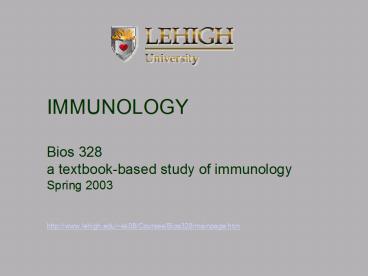FIRST HALF OF TODAY - PowerPoint PPT Presentation
1 / 23
Title:
FIRST HALF OF TODAY
Description:
All three general functions (Ag binding, complement activation, stimulation of ... co-los-trum kc- l s-tram n [L. beestings] (1577) ... – PowerPoint PPT presentation
Number of Views:28
Avg rating:3.0/5.0
Title: FIRST HALF OF TODAY
1
(No Transcript)
2
(No Transcript)
3
(No Transcript)
4
FIRST HALF OF TODAYS CLASS THE IMMUNOGLOBULINS
5
A quick overview of the five immnoglobulin
classes
- IgG (( globulin) the prototypic immunoglobulin.
- All three general functions (Ag binding,
complement activation, stimulation of
phagocytosis) occur. - IgM (macroglobulin) often the first
- IgA the secretory immunoglobulin
- IgD regulatory?
- IgE functions with parasites and allergens
6
IgG (( globulin)
- IgG is the principal immunoglobulin of the
secondary response. - IgG is the principal immunoglobulin of the adult
(but not the neonate.) - IgG constitutes 80 of the circulating
immunoglobulin in the adult. - The concentration of IgG in serum is high 8-16
mg ml-1. - The architecture of IgG is simple
- two ( chains and two 8 chains or
- two ( chains and two 6 chains.
7
IgM (macroglobulin)
- a pentamer (in secreted form) attached by
disulfide bonds between the C4 and C3 domains of
adjacent heavy chains - in addition, there is a single J-protein.
- IgM is the first immunoglobulin to be synthesized
in a primary response. - The concentration of IgM in serum is 1.5 mg
ml-1. - IgM is the first immunoglobulin to accumulate in
the serum of neonates. - IgM has a high valency which contributes to
agglutination. Also, multimeric nature
contributes to effective complement activation. - mIgM is a monomer.
8
Some visual reinforcement
9
Some more visual reinforcement
10
co-los-trum \kc-läs-tram \ n \ L. beestings
(1577) milk secreted for a few days after
parturition and characterized by high protein and
antibody content
11
IgA (the secreted antibody)
- Most often a dimer sometimes a tetramer (or a
trimer). - Multimers united by J-protein.
- Secretion requires addition of secretory
component produced in mucosal epithelial cells
(in digestive, respiratory, genital, breast
tissues and salivary and lacrimal glands). - Plasma cells secrete the Ab
- deliver IgA to epithelial cells having
poly-Ig-receptor on their surface. - The poly-Ig-receptor is cleaved and the
component that stays associated with IgA is the
secretory component. - MW 70,000 daltons composed of 5
immunoglobulin-like domains - binds to constant regions of heavy chains.
- Movement of the receptor from one surface to
another is transcytosis.
12
Visual reinforcement
13
IgD and IgE
- IgE is extremely rare.
- 0.0003 mg ml-1 serum
- IgE functions against parasites.
- In the absence of para-
- sites, IgE responds to allergens.
- IgD is very rare.
- 0.03 mg ml-1serum
- What does this imply?
14
IgE
- IgE is extremely rare.
- IgE functions against parasites.
- In the absence of para-
- sites, IgE responds to allergens.
15
And, there are subtypes, too
16
Hinges versus domains
- Hinges contribute to flexibility. They contain
cysteine and proline. Cysteine provides
interchain linkage. Proline cannot be
incorporated into secondary structure. - Immunoglobulins without hinge regions have an
extra domain.
17
Isotypes, allotypes, idiotypes
- ISOTYPE one of the five ((, ", , , ,) major
kinds of heavy chains in immunoglobulins. Note
that the differences among the isotypes are in
the constant region. - Indeed, different isotypes can share common
variable regions! (Think about that.) - ALLOTYPE the allelic variation seen at loci
specifying the light and heavy chains of
immunoglobulins. - IDIOTYPE The set of antigenic determinants
(idiotopes) characterizing each unique antibody
(or T-cell receptor). Idiotopes are single
antigenic determinant(s) in the variable domains
of an antibody (or T-cell receptor). Idiotopes
are generated by the unique amino acid sequence
specific for each antigen.
18
Isotypes, allotypes, idiotypes
19
IMPORTANT
- One B-cell makes one type of antibody.
- (More exactly, one B-cell makes one idiotype.)
- (This equation is the basis of monoclonal
antibodies but we are going to ignore monoclonals
for the time being.) - Igs first appear on the surface of B-cells
there they are selected. - The B-cells mature to plasma cells and secrete
antibodies with the same specificity (i. e., same
idiotypic identity same antigen specificity.)
20
Visual reinforcement
21
Visual reinforcement
- The carboxy terminus of the mIg, penetrates into
the cytoplasm by only a few amino acids. But mIg
is always associated with pairs of the dimer Ig-"
/ Ig-. - These associated dimers have longer carboxy
tails, 61 amino acids and 48 amino acids
respectively. The tails contain tyrosine
residues which can be phosphorylated by kinases
the phosphorylated or un-phosphorylated states
constitute a molecular switch conforming to an on
/ off switch. - (Immunological phenomena affected by kinases
tend to use tyrosine as the receptor of
phosphates while other cellular phenomena tend to
use serine or threonine.)
22
Time to review
23
Time to review
- Isotype, allotype, idiotype
- implies that epitopes (at least experimentally)
are proteins - proteins are specified by genes
- how do genes specify the numerous, diverse,
highly specific immunoglobulins? (BIG
question!)
- Time to review
- take a 5 break!































